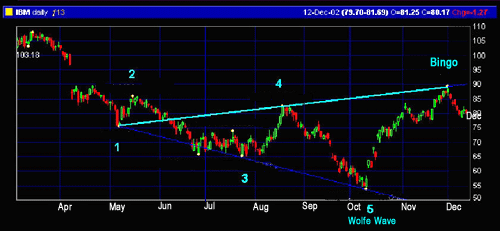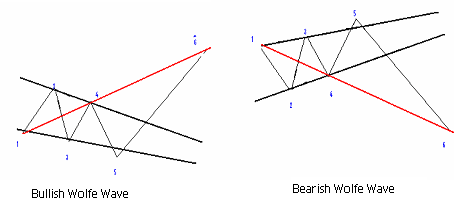Wolfe Waves were discovered by a trader by the name of Bill Wolfe after "thirty some odd years of studying". Apart from using some odd english, Mr Wolfe also liked to put his name to existing patterns, as a Wolfe Wave really is no more than a wedge pattern, with a specific wave count to it. Despite this, the Wolfe Wave can be a powerful tool in your naked arsenal, if used in the right context, which I will go into here.
My knowledge on these waves derive from both trading them for "seven some odd years" and the official Wolfe Wave manual written by Bill Wolfe himself. Unfortunately the essence of what a Wolfe Wave is representing is lost in many circles, so hopefully we can clarify things a little.
First of all, what a Wolfe Wave look like, for this, I will let Bill himself show you:

You can see from these basic example charts, that a Wolfe Wave is essentially an ascending or descending wedge depending on the market conditions (more on that later). For a wedge to be called a Wolfe Wave it must consist of four waves with the end of the fourth wave (marked 5 in the above charts) reaching, or exceeding the wedge pattern extremes.
EPA stands for Estimated Price at Arrival, which doubles as your profit taking line. ETA, stands for Estimated Time of Arrival and should be completely ignored, even Wolfe himself acknowledged that which makes you wonder why he mentioned it at all really. Wolfe's basic premise for trading these patterns is to wait for point 5 to enter a trade, and look for the line marked EPA to be your target, hopefully arriving right on time (ETA).
So that is Wolfe theory out of the way (yep the manual doesn't go into too much more in it's thirty odd pages), but let's look at a real world example, as shown on the cable chart of early December 2008:
 Looks wonderfully easy in hindsight doesn't it. So why do they work (sometimes)? Wolfe waves work on the psychological frailty of the novice trader. The best Wolfe waves tend to be those that are pointing in the direction of the established trend.
Looks wonderfully easy in hindsight doesn't it. So why do they work (sometimes)? Wolfe waves work on the psychological frailty of the novice trader. The best Wolfe waves tend to be those that are pointing in the direction of the established trend.
Trends are wonderfully easy to find after they have confirmed themselves with three to four waves. Before that they look like a standard retracement in the previous trends direction. It is only after that retracement fails, that a new trend is suspected, and once a new high/low is set in the opposite direction, it is then we can think a new trend is has formed.
The professional/experienced trader can usually find signs of these developing trends earlier and jump on the departing train. The inexperienced trader, needs multiple confirmations, quite often from various squiggly lines before they agree a trend is in place. The result being increased pressure on the retracements in the final stages of the trend from the late arrivals, meanwhile the big money slowly jumps of the impending train wreck, meaning shallower proportional breaks of new highs and lows.
Really the Wolfe wave is no more than a technique to trade a matured wedge pattern, telling you where to enter, and where to look to take profits. The entry is based on the concept of a final exhaustive run in the direction of the trend, using up the last of the buyers/sellers. Price then reverses suddenly and heads off towards the EPA, which hold similar concepts to the Axis lines I talked about in a previous article.
So how do you trade it. To trade a Wolfe wave consistently you need to recognise the inherent weakness of the technique itself, that is;
- You are trying to catch a falling knife.
- You are entering after a new high or low has been made, making identifying entry locations difficult.
- Your trip to your target is against the previous trend .. making it a bumpy ride at times as people get out of positions.
Below is a visual step through of the above mentioned Wolfe wave trade that I hope will help in visualising their potential, click to get full sized images:
At times point 4 can be a little messy or ambiguous, such as was this case this time, if that is the case, drawing alternate EPA's can help in finding the best exit point. If you are a conservative trader, you can shoot for the closest EPA, else the more aggressive trader might look for the next EPA:
 Trading Wolfe waves, or any type of wedge pattern can be a very profitable way to trade. It has you entering during quite times and trying to ride out the powerful moves that follow. The key is patience, to firstly, get the right entry and not jump in too early, second, to stick with the entry while it bobbles around, third to not be shaken out by the odd headfake, and finally to ride that baby for all it's got.
Trading Wolfe waves, or any type of wedge pattern can be a very profitable way to trade. It has you entering during quite times and trying to ride out the powerful moves that follow. The key is patience, to firstly, get the right entry and not jump in too early, second, to stick with the entry while it bobbles around, third to not be shaken out by the odd headfake, and finally to ride that baby for all it's got.
To minimise your entry risk, and maximise your risk reward ratio, look for previous support/resistancein the area of the sweet spot (marked in light grey on the charts), especially if it is from a time frame above what you found the Wolfe Wave on. If that fails, extensions can help to get a general area to look for a price trigger, such as the hammer candle seen in the above chart.
There are more nuances to the Wolfe Wave I have not listed here, but this should get you on your way. If you trade one, or wonder if you are spotting them correctly, throw a post over at the newbeginnertrader {forum}, and if you can, grab a copy of the Wolfe Wave manual if you get a chance to get it straight from the horses mouth.
























